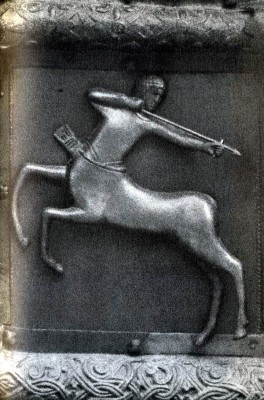Tales of Solomon and Kitovras
The Serbian Alexandreid and The Trojan History are examples of the “high” courtly literature that entered Russian letters in the fifteenth century. But during the same period several other works of quite a different nature, close to the oral tradition of the Middle Ages, also appeared in Russia. One of the first specimens of this genre was the tales of King Solomon and the beast Kitovras that are mentioned in mediaeval lists of proscribed books (indexes), but from the end of the fifteenth century were included in the Old Russian Interpretive Paleya which set out and explained Bible stories.22

Kitovras. Detail of Korsun Doors in the Cathedral of St Sophia in Novgorod. Addition by a 14th-century Russian master
The prototype of mediaeval legends about Solomon was the Old Testament story of how King Solomon settled a dispute between two women who both claimed to be the mother of the same infant. The king ordered the child to be cut in half: when one of the women agreed to hand over the child to the other rather than let it be killed, the king immediately knew that she was the real mother. This Bible story provided the model for the Judgements of Solomon, which was not part of the Bible, but was included in the Interpretive Paleya. One of the chapters of the Judgements tells about three people who accuse one another of stealing purses of gold while the two others were asleep. They appeal to Solomon and he tells them a parable. A certain girl was betrothed to a young man who went away to another land and forgot about her. Time passed and the girl’s father decided to give her in marriage, but she confessed to her bridegroom that she was already betrothed. The bridegroom agreed to go with his bride to her betrothed, who freed the girl from her vows. On the way back a robber attacked the young couple, but when the girl told him her story he let them go unharmed. After hearing the parable, one of the people said that the betrothed had behaved best, another the bridegroom, while the third praised the robber, but said that he should have taken the belongings of the bridegroom and the girl. “You covet the possessions of others, my friend, it was you who took the purse…” said Solomon.23
The tales about Kitovras are similar to those about Solomon, but here the king has a rival who is even wiser than he. These tales tell how King Solomon decided to build the temple in Jerusalem and needed the help of a “fleet-footed beast”, Kitovras (the legendary centaur, half-man and half-beast). Thinking it would be impossible to persuade him, Solomon’s counsellors decide to capture Kitovras by a clever ruse. They fill some wells with wine and honey; Kitovras drinks from them and falls asleep. The counsellors fetter him and take him to the king. The captured Kitovras surprises everyone by his behaviour: he laughs at a man in the market who is choosing himself a pair of boots to last seven years and at a fortune-teller sitting on the ground, and cries at the sight of a wedding; later it transpires that the buyer of the boots had only seven days to live, that the bridegroom was to die shortly as well and that the fortune-teller did not know that there was some treasure buried under the spot where he was sitting. Kitovras tells them how to get the shamir stone needed to polish the slabs for the future temple. The temple is built, but the king doubts Kitovras’ wisdom, for it did not save the “fleet-footed beast” from being captured by men. Then Kitovras asks the king to take off his chains and carries Solomon away to the ends of the earth where his wise men and scribes have to seek for him. After that the king is so afraid of Kitovras that he has sixty brave warriors stand guard by his bedside every night.
Apart from this tale about Kitovras, several more have survived. The miscellany of the White Lake Monastery of St Cyril scribe Euphrosyne contains a short but very interesting tale in which the capture of Kitovras is due to the cunning wife, whom the “fleet-footed beast” conceals in his ear. But his wife manages to tell “her young lover” about the wells from which Kitovras usually drinks; and after this they put wine in them. The meeting of Kitovras and Solomon is described differently here. “What is the finest thing in the world?” asks the king. “Freedom,” replies Kitovras, breaking everything and leaping free. A third tale about Kitovras, which has survived only in manuscripts of the seventeenth century and later, also includes the theme of female cunning. Here the victim is not Kitovras but Solomon. With the help of a magician Kitovras steals Solomon’s wife. Solomon sets off to get her back, but due to his wife’s treachery falls into Kitovras’ hands. The king is sent to the gallows, but asks permission to play on his horn. In reply to a triple call from Solomon’s horn his army appears; the king is freed and executes Kitovras, his wife and the magician.24
There is no evaluation of the character of Kitovras in the tales about him: we cannot say whether he is good or evil. He helps Solomon to build the temple, but he also takes him to the ends of the earth. The reader had to decide for himself what he thought of this main character.
 History of Russian Literature
History of Russian Literature
